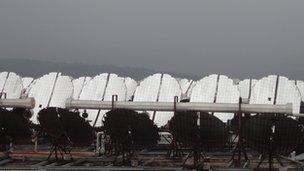India's mobile phone firms turn to green power
- Published
Thanks to India's erratic power supplies, over 60% of telecom masts currently rely on diesel generators, says the BBC's Shilpa Kannan
Nearly a billion people use mobile phones in India and a network of broadcast masts helps to keep them talking.
But keeping these towers working 24 hours a day, seven days a week, consumes a lot of energy.
Towers that are located in urban areas are usually connected to the main grid to get electricity.
But most locations in India do not get a continuous or even good quality grid supply, and more than 60% of the towers depend on diesel-powered generators.
Each mast requires about the same amount of energy as the average urban household.
But with 400,000 across the country - and many more planned - the total is huge, and it is perhaps no surprise that India is asking if they can switch to cleaner energy.
Going hybrid
The telecom industry one of India's largest consumers of diesel fuel at nearly two billion litres every year, which is both expensive and polluting.
The local telecom regulator has recommended that companies reduce their dependency on diesel and cut carbon emissions by 50% at all rural towers and 20% at urban towers.
Their solution is to run these towers on hybrid power, a combination of renewable and grid power.
But experts warn that it will not be easy.
Mohit Rana of management consultancy firm AT Kearney says that solar is the most efficient source currently, but even that does not come cheap.
"To do that, companies need about $15,000 (£9,500) additional investment. At least at the current point of time, industry doesn't find it viable to incur that expenditure," he says.
But reducing diesel dependency is something that the industry is already working on.
AT Kearney estimates that almost 50% of the current carbon footprint of the telecom sector can be attributed to diesel.
Big savings
Bharti Infratel is one of the companies trying to meet these targets. The firm has more than 33,000 towers, of which nearly 9,000 are in off-grid or poorly supplied locations.
Even though the government subsidises the price of diesel heavily, it is an expensive option and one that affects the company's profit and loss, or P&L as it is also known.

Solar energy is considered one of the most efficient alternative sources of energy in India
"Fuel to me is the largest cost on my P&L today," says Devender Singh Rawat, chief executive of Bharti Infratel.
"Fuel costs can vary from 5,000 rupees ($90; £57) to 40,000 rupees ($720; £460) depending on grid electricity availability in an area."
The company has begun the shift to sustainable sources of energy at more than 1,000 tower sites. This has led to savings of nearly seven million litres of diesel a year.
Cut-throat competition
But telecom companies cannot afford to take on the role of electricity generation themselves.
This has created an opportunity for entrepreneurs, who are looking at the technology as a means to both go green and make money.
OMC Power is one company that is setting up micro-power plants in rural locations for telecom companies.
They will tap into green energy sources like solar, wind and biogas, and provide a clean power source in remote areas.
Anil Raj of OMC Power says there is going to be a big shift in the way power is consumed in India.
"The existing paradigm is of having very large power plants and inefficient transmission networks," he says.
"So you generate power far away, then you bring it through transmission lines and distribute it here.
"That is changing. So what we are going to see now is that you generate and consume power locally."
The biggest challenge remains the commercial viability of green power.
But firms hope that tower companies can be the anchor clients in a remote location, and the extra energy can be distributed to the residential areas around them.
Mr Raj says the energy they produce will be shared between the telecom company and the local community, which will get small battery packs that can be used to light up a home or charge small appliances.
OMC Power hopes that by using a hybrid of techniques, it can keep the costs down as there will be little or no wastage.
Pegging prices will be important as the Indian telecom market is already suffering from falling revenues and cut-throat competition.
In an attempt to further develop the market, the country is expected to add another 300,000 towers over the next five years.
Unless an effective clean energy model is developed soon, many fear that fuel costs will bleed an industry that is already heavily in debt.
- Published31 July 2012
- Published31 July 2012
- Published27 June 2012